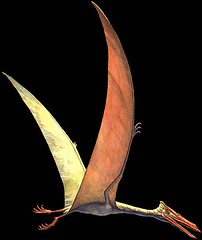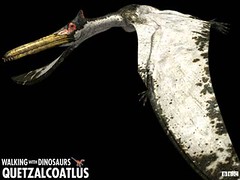Quetzalcoatlus was a huge pterosaur with a wingspan of up to 13 metres - the largest flying creature of all time. It is the last known pterosaur and survived to the very end of the Cretaceous period.
Despite its huge size, its skeleton was lightly built and the whole animal probably weighed no more than 100 kilograms. It was a good soarer - certainly able to cover large distances. Its neck was extremely long, its slender jaws were toothless and its head was topped by a long, bony crest.
Douglas Lawson was the first to find a Quetzalcoatlus fossil, at Big Bend National Park in Texas, USA. Unlike most other pterosaur fossils these remains were not found in marine strata but in the sand and silt of a large river's flood plain. This raised questions about how it lived.
The fact that Quetzalcoatlus had a long neck, and that it can soar has prompted the idea that it lived rather like a vulture and fed on the corpses of dead dinosaurs. But some palaeontologists, noting the long slender jaws suggest that it probed soft ground and pools for molluscs and crustaceans. Others think that it flew low over the warm shallow seas plucking fish from the surface.
Lawson named the pterosaur after the Aztec's feathered-serpent god, Quetzalcoatl.

Despite its huge size, its skeleton was lightly built and the whole animal probably weighed no more than 100 kilograms. It was a good soarer - certainly able to cover large distances. Its neck was extremely long, its slender jaws were toothless and its head was topped by a long, bony crest.
Douglas Lawson was the first to find a Quetzalcoatlus fossil, at Big Bend National Park in Texas, USA. Unlike most other pterosaur fossils these remains were not found in marine strata but in the sand and silt of a large river's flood plain. This raised questions about how it lived.
The fact that Quetzalcoatlus had a long neck, and that it can soar has prompted the idea that it lived rather like a vulture and fed on the corpses of dead dinosaurs. But some palaeontologists, noting the long slender jaws suggest that it probed soft ground and pools for molluscs and crustaceans. Others think that it flew low over the warm shallow seas plucking fish from the surface.
Lawson named the pterosaur after the Aztec's feathered-serpent god, Quetzalcoatl.

No hay comentarios.:
Publicar un comentario
¡Comenta ya!
Send your Owler or Howler!
***
Si no quieres responder con tu cuenta google o wordpress o etc, puedes escoger poner tu nombre con la opción Nombre/URL.